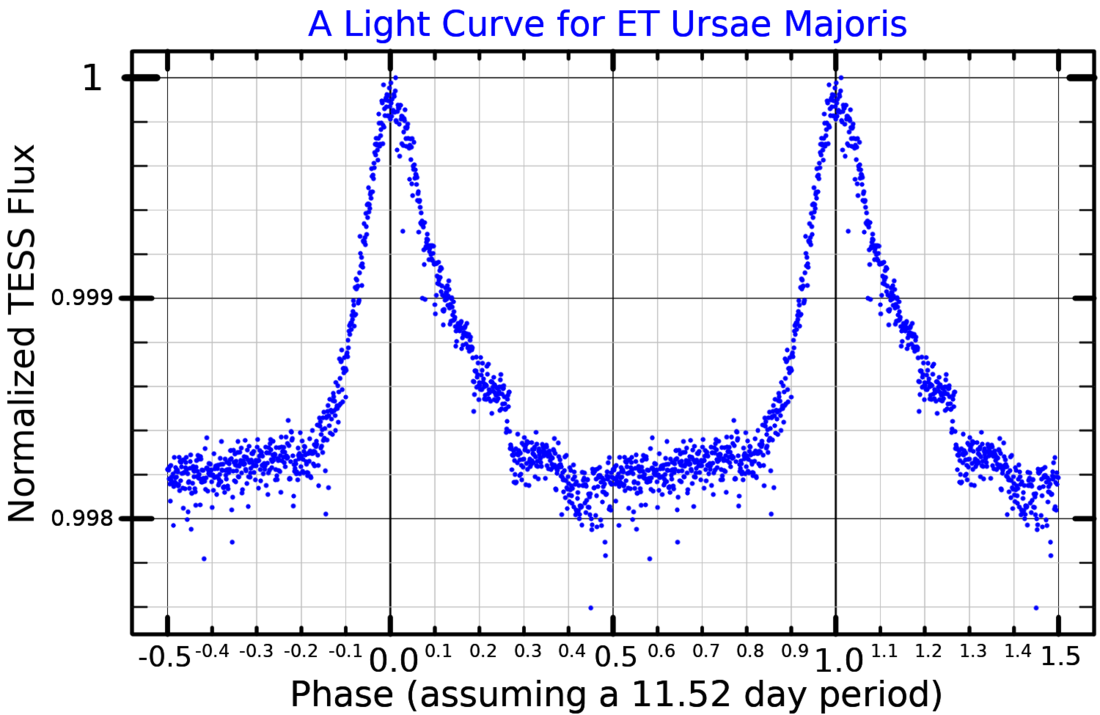HR 4072
Star in the constellation Ursa Major From Wikipedia, the free encyclopedia
HR 4072 is a binary star[9] system in the northern circumpolar constellation of Ursa Major. It has the variable star designation ET Ursae Majoris, abbreviated ET UMa,[5] while HR 4072 is the system's designation from the Bright Star Catalogue. It has a white hue and is faintly visible to the naked eye with an apparent visual magnitude that fluctuates around 4.94.[3] The system is located at a distance of approximately 339 light years from the Sun based on parallax measurements.[2] The radial velocity measurement is poorly constrained, but it appears to be drifting closer to the Sun at the rate of around −3 km/s.[3]
| Observation data Epoch J2000 Equinox J2000 | |
|---|---|
| Constellation | Ursa Major |
| Right ascension | 10h 24m 07.84801s[2] |
| Declination | +65° 33′ 59.1239″[2] |
| Apparent magnitude (V) | 4.94[3] |
| Characteristics | |
| Spectral type | A1:VpSiSrHg[4] |
| B−V color index | −0.052±0.012[3] |
| Variable type | α2 CVn[5] |
| Astrometry | |
| Radial velocity (Rv) | −2.24±0.03[6] km/s |
| Proper motion (μ) | RA: −9.427[2] mas/yr Dec.: −20.994[2] mas/yr |
| Parallax (π) | 9.61±0.20 mas[2] |
| Distance | 339 ± 7 ly (104 ± 2 pc) |
| Absolute magnitude (MV) | −0.15[3] |
| Orbit[6] | |
| Period (P) | 11.579113±0.000010 d |
| Semi-major axis (a) | 1.634±0.001 mas |
| Eccentricity (e) | 0.2943±0.0009 |
| Longitude of the node (Ω) | 133.49±0.13° |
| Periastron epoch (T) | 2,457,756.168±0.005 JD |
| Argument of periastron (ω) (primary) | 176.50±0.20° |
| Semi-amplitude (K1) (primary) | 38.17±0.04 km/s |
| Semi-amplitude (K2) (secondary) | 62.11±0.09 km/s |
| Details[6] | |
| A | |
| Mass | 2.779±0.153 M☉ |
| Radius | 3.16±0.11 R☉ |
| Luminosity | 101±8 L☉ |
| Surface gravity (log g) | 3.88±0.05 cgs |
| Temperature | 10,260±100 K |
| Metallicity | = +0.11±0.04 |
| Metallicity [Fe/H] | +0.39[7] dex |
| Rotational velocity (v sin i) | ≤4.2 km/s |
| B | |
| Mass | 1.708±0.094 M☉ |
| Radius | 1.73±0.06 R☉ |
| Luminosity | 9.7±1.0 L☉ |
| Surface gravity (log g) | 4.22±0.05 cgs |
| Temperature | 7,860±140 K |
| Metallicity | = −0.05±0.07 |
| Rotational velocity (v sin i) | 5.1±2.1 km/s |
| Other designations | |
| ET UMa, BD+66 664, GJ 9327, HD 89822, HIP 50933, HR 4072, SAO 15163, PPM 17427, PLX 2433, TYC 4150-1302-1, IRAS 10205+6549, 2MASS J10240782+6533590[8] | |
| Database references | |
| SIMBAD | data |
This is a double-lined spectroscopic binary[7] star system with an orbital period of 11.58 days and an eccentricity of 0.29.[6] The orbit for this star was first determined by R. H. Baker in 1912, then later revised.[10][6]
The primary, designated component A, is an Ap type chemically-peculiar star[11][12][13] with a stellar classification of A1:VpSiSrHg,[4] although it has also been considered to be a mercury-manganese star.[14] The suffix notation indicates abundance anomalies of silicon, strontium, and mercury in the spectrum. It is an α2 Canum Venaticorum variable with an amplitude of 0.05 magnitude in the B (blue) band.[5] The star is rotating slowly with a projected rotational velocity of 4.5 km/s.[7] It is three times larger than the Sun, radiating about 100 solar luminosities from its photosphere at an effective temperature of 10,260 K.[6]
The secondary component has been reported to have characteristics of an Am star.[12] It is a F-type star with 1.73 times the size of the Sun and 1.71 times its mass. Its luminosity is about 10 times that of the Sun, or one-tenth of that of the primary, and it has an effective temperature of 7,900 K.[6]
References
Wikiwand - on
Seamless Wikipedia browsing. On steroids.


![{\displaystyle {\begin{smallmatrix}\left[{\ce {M}}/{\ce {H}}\right]\end{smallmatrix}}}](http://wikimedia.org/api/rest_v1/media/math/render/svg/d9a106d03666c72cc54c1dff07a5637d3adda9a1)